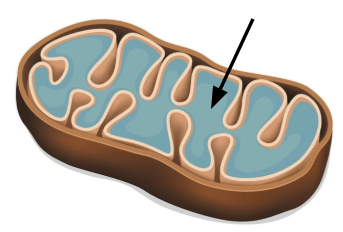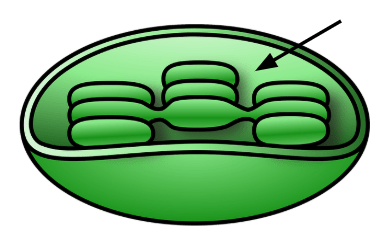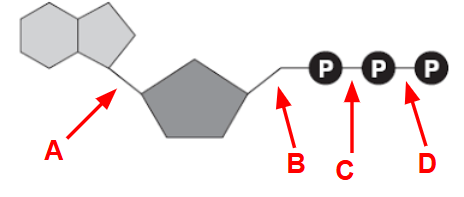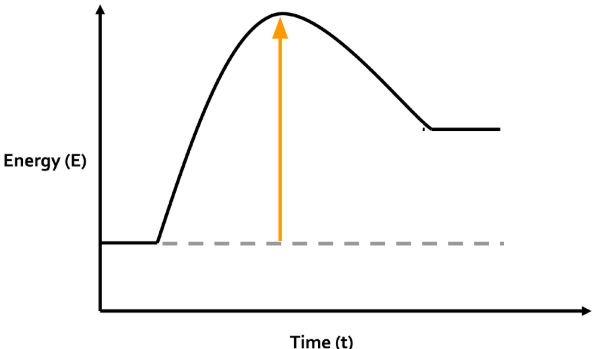What is the negative subatomic particle in an atom?
Electron
A biological catalyst that speeds up a reaction is called a(n)... ?
enzyme
What is the term for when there is attraction between molecules of the same substance (such as water molecules hydrogen bonding to other water molecules)?
Cohesion
What molecule is pictured below?

ATP!
What are the two reactants (inputs) of cellular respiration?
Glucose (C6H12O6) and Oxygen (O2)
What are the TWO chemical inputs (reactants) of photosynthesis?
Carbon Dioxide (CO2) and Water (H2O)
What is the smallest unit of matter?
ATOM!
What is it called when a protein, such as an enzyme, changes structure due to temperature or pH?
Denatured
Water molecules sticking to another substance, such as glass, is an example of which property of water?
Adhesion
Energy is released and can be used for cellular work when ATP becomes _____.
ADP
The arrow is pointing to the internal fluid that fills the mitochondria and it is called _____ ?

The Matrix
The fluid that fills the inside of the chloroplast (pointed to in the image below) is called what?

Stroma
How many protons, electrons, AND neutrons, does Sodium-23 have?
(Sodium is Na on the periodic table)
11 protons, 11 electrons, and 12 neutrons
What is the term for the reactant used in an enzyme reaction?
Substrate
Select the correct bolded terms: Acids are substances that release [ H+ / OH- ] ions and have a pH that is [ greater / less ] than 7
H+ ; less
Which arrow is pointing to the high energy bond in ATP?

What is the first step in cellular respiration called AND where in the cell does it occur?
Glycolysis; Cytoplasm
Chlorophyll pigments absorb energy from most colors of light, except which TWO colors?
Green and Yellow
Write the element name AND mass number of an atom that has 15 protons, 15 electrons, and 17 neutrons.
Phosphorus-32
What location on an enzyme does the substrate attach to?
Active Site
What is the property of water that describes its ability to absorb a lot of energy without changing that much in temperature?
High Heat Capacity
Which letter (A, B, C or D) represent energy from food?

A
Which step of cell respiration produces the MOST ATP (32 ATP)?
Electron Transport Chain (ETC)
In the light-dependent reactions, molecules of _____ are turned into molecules of _____.
Water; Oxygen
What are TWO SIMILARITIES and TWO DIFFERENCES between two atoms that are isotopes
Similarities: same element, atomic number, # protons, # electrons
Differences: mass number, # neutrons
What does the yellow arrow represent? AND is this reaction endothermic or exothermic?

Activation Energy; Endothermic
Select the correct bolded terms:
Water is a [ polar / nonpolar ] molecule. The oxygen atom in a water molecule has a partial [ negative / positive ] charge, while the hydrogen atoms have a partial [ negative / positive ] charge.
polar; negative; positive
How much ATP can be made from breaking down a single lipid (triglyceride)?
A. 2 B. 32 C. 36 D.136 E. 146
E. 146
There are TWO steps in Cellular Respiration that BOTH produce 2 ATP. What are the name of these two steps?
Glycolysis and Krebs Cycle (or Citric Acid Cycle)
In the light-independent reactions, molecules of _____ are turned into molecules of _____.
Carbon Dioxide; Glucose